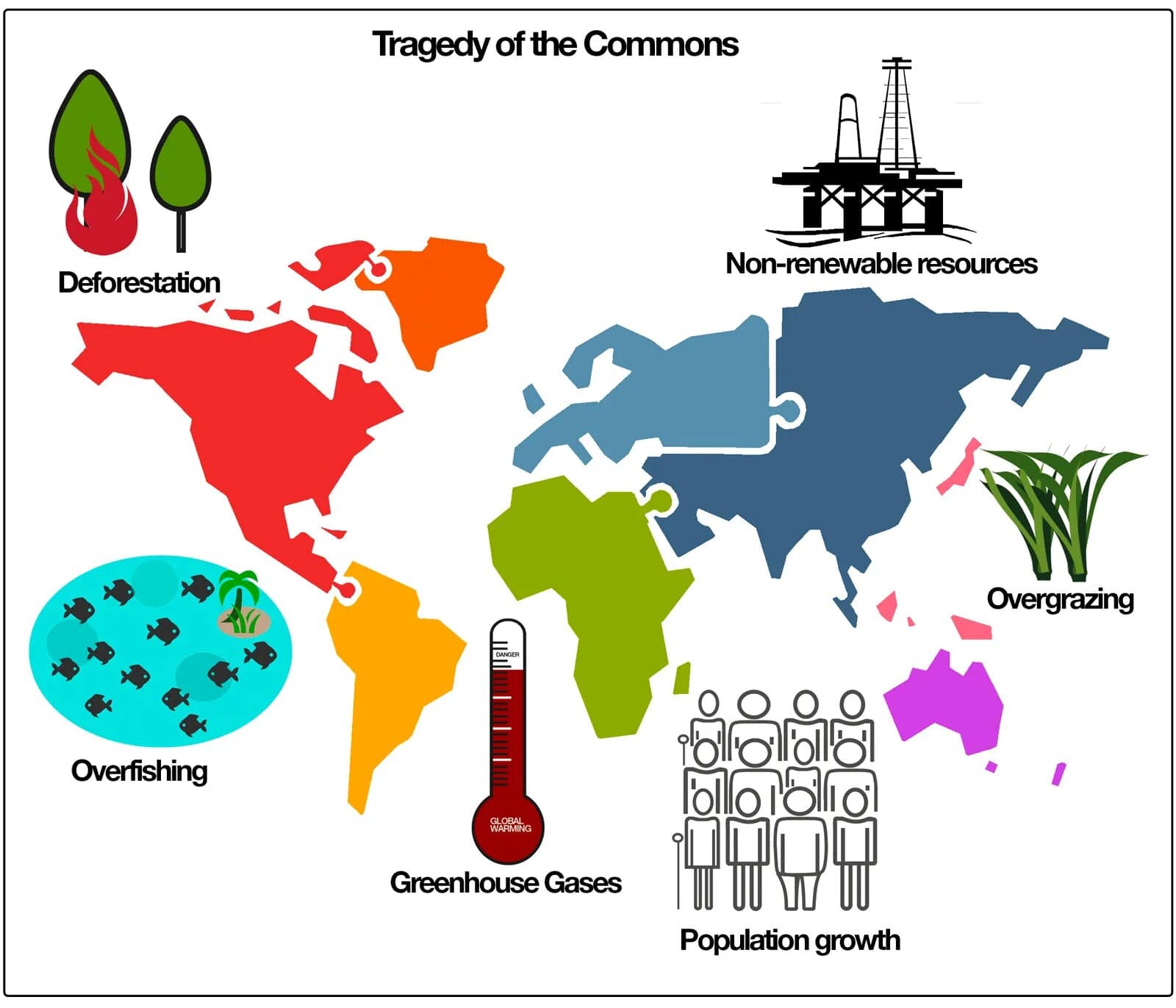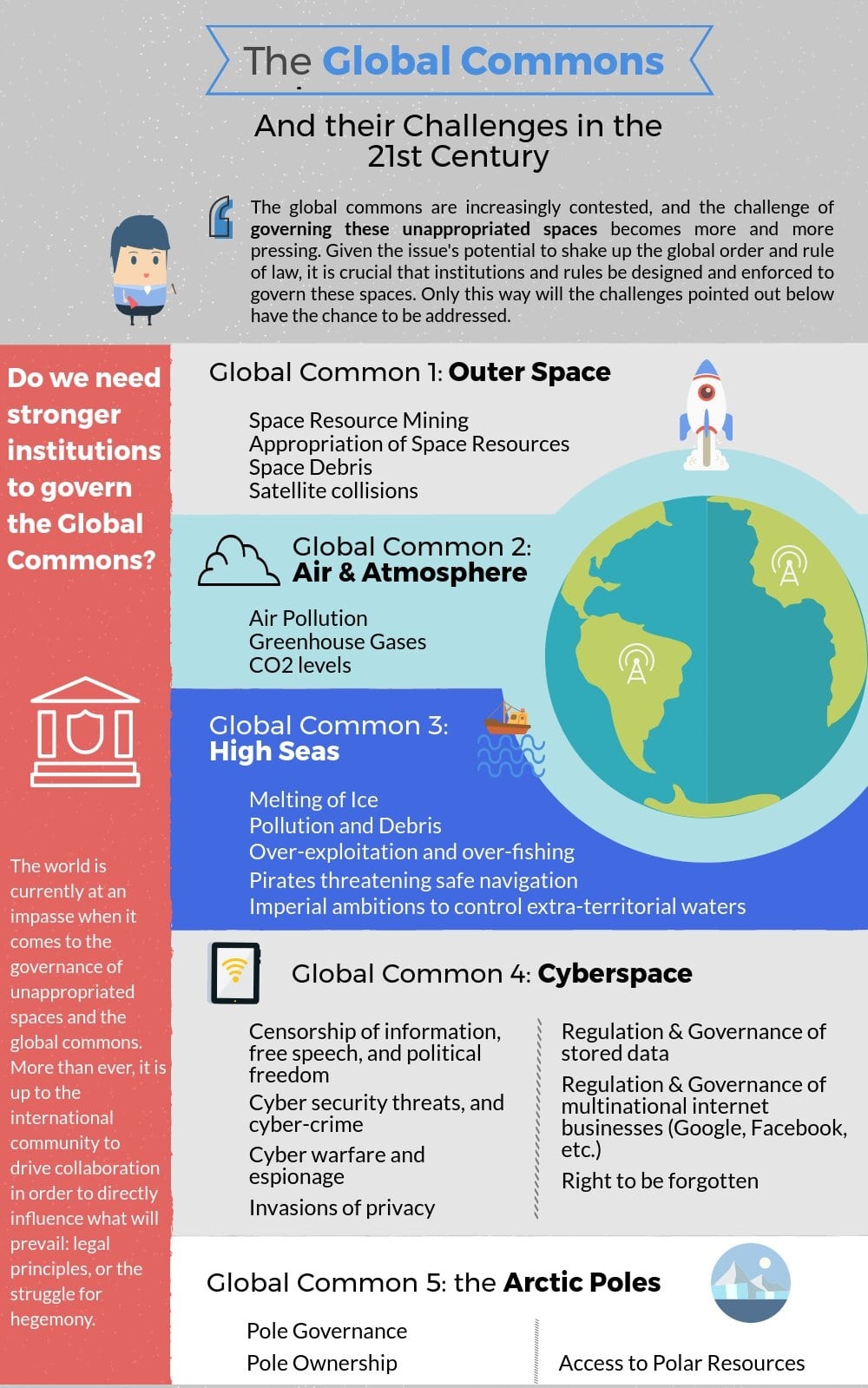Biodiversity & Environment
Global Commons At Threat
The given article is based upon ‘Managing The Global Commons’ which was published in ‘The Hindu’ on 30/09/2020. It talks about how and why the global common resources are being used excessively and what is the way forward to prevent the indiscriminate exploitation.
The world has lately faced a pandemic, record-breaking forest fires, floods and droughts in various places, and the rapid melting of Arctic ice.
One of the main causes behind such events is the disruption of our environment which unfortunately, has been recognised at global scale only in the past few years.
To cope with these events, we need to increase our efforts in managing our interactions with the environment on a global scale where the prime areas of concern are the global commons.
Global Commons
- Global commons have been traditionally defined as those parts of the planet that fall outside national jurisdictions and to which all nations have access.
- They do not belong to one community or individual, but to humanity.
- International law identifies four global commons, namely
- The high Seas
- The atmosphere
- Antarctica
- The Outer Space.
- Resources of interest or value to the welfare of the community of nations – such as tropical rain forests and biodiversity - have lately been included among the traditional set of global commons as well.
Significance of Commons
Globally
- Area: A third of the global population depends on ‘Commons’ for their survival; 65% of the global land area is under ‘Commons’, in different forms.
- Carbon storage: At least 293,061 million metric tonnes of carbon (MtC) are stored in the collective forestlands of indigenous peoples and local communities.
- Pollination: The significance of ‘Commons’ in supporting pollination (the cost estimated to be worth $224 billion annually at global levels) cannot be overlooked.
In India’s Context
- Area: In India, the extent of ‘Common’ land ranges between 48.69 million and 84.2 million hectares, constituting 15-25% of its total geographical area.
- ‘Common’-pool resources: They contribute $5 billion a year to the incomes of poor Indian households.
- Around 77% of India’s livestock is kept in grazing-based or extensive systems and dependent on ‘Commons’ pool resources.
- And 53% of India’s milk and 74% of its meat requirements are met from livestock kept in extensive ‘Common’ systems..
Issues Related To Global Commons
- According to a report by the Convention on Biological Diversity (CBD), the biodiversity has been mismanaged so badly that 60% of the lost resources can never be recouped.
- The spread of zoonotic diseases like Covid-19, Greenhouse Gas Emissions, biodiversity reduction, overfishing; and the accumulation of plastic waste are some of the problems within the scope of global commons.
- Multilateral Negotiations on Climate Change and other global commons over decades have had limited success.
- Although we have a good idea of what kind of governance might be successful at the local community level, these insights do not directly address the challenges we face on a global scale.
- Another possible reason is that countries are selfish to their own cause. Hence, they do not pay much heed to the alarming conditions of global commons.
- At local level: Community members may have more knowledge about the local ecological and social context, but they could also lack expertise or may be ruled by powerful factions within the community, or may not perceive sufficient incentives to sustain the local commons.
- The urge of the rich and powerful to privatise these resources for individual prosperity in the form of property management principles, intellectual property rights and others has also led to the decline in the availability of ‘commons’.
- In India: Despite their significance, ‘Commons’ have suffered continued decline and degradation.
- National Sample Survey Office data show a 1.9% quinquennial rate of decline in the area of ‘Common’ lands, though microstudies show a much more rapid decline of 31-55% over 50 years,
- This has jeopardised the health of systemic drivers such as soil, moisture, nutrient, biomass and biodiversity, in turn aggravating food, fodder and water crises.
- National Sample Survey Office data show a 1.9% quinquennial rate of decline in the area of ‘Common’ lands, though microstudies show a much more rapid decline of 31-55% over 50 years,
Steps That Can Be Taken
- In order to manage shared resources, a balance between both private and public interests needs to be maintained.
- Coordinated Activities: Coordinates activities at different scales should be performed.
- For example, local irrigation communities could monitor the state of infrastructure and water use and adapt their watering scheme or cropping patterns to changes in water availability.
- Managing both the global and local commons: To manage our global commons, we need to facilitate and accommodate the self- governance of local commons, but provide safeguards at different levels to avoid exploitation and manage risks.
- Rural and Urban Communities: Facilitate the rural and urban communities to self-govern their shared resources.
- However, there will be risks involved for which the cities and nations will have to take up the responsibilities.
- The two Specific Approaches: In addition to seeking more money, time and capacities to deal common resources management, we need to focus on two specific approaches:
- To re-introduce more strongly, the management and governance principles of ‘Commons’ approaches into decision-making and implementation of conservation, use and benefit sharing action.
- To use the approach of creative destruction to put resource management in the hands of the people.
Creative Destruction
- Creative destruction refers to the incessant product and process innovation mechanism by which new production units replace outdated ones.
- It was coined in 1942 by Joseph Schumpeter, an Austrian Economist, who considered it ‘the essential fact about capitalism’.
Further Possible Challenges
Governing the global commons is the defining challenge for current and future generations:
- The opposing and dominant world view of the ‘developmentalists’ is predicated on the value of built infrastructure, and requires the constant colonisation of open land and resources.
- Failures will be inevitable if we stimulate local-level experimentation, and higher-level authorities need to provide insurance for those cases.
- If local initiatives are successful, higher-level authorities need to provide insurance that the outcomes of those successes will not be grabbed by outsiders.
- While the state can have oversight over resource management, keeping people away from using and managing ‘Commons’ is against effective governance of ‘Commons’.
Conclusion
- Commons are the resources relevant not only for rural communities but are now a major provider of livelihood options for both urban and peri-urban populations as well.
- The relevance of ‘Commons’ impacting urban dwellers cannot be overlooked with more urbanisation happening.
- What is desperately needed at this moment is a manifesto for the protection of the commons and open lands, and for the re-creation of economies that derive value out of healing wounded landscapes and covering open lands with diverse vegetation, water and life.
|
Drishti Mains Question There is a need to increase efforts in managing our interactions with the environment on a global scale. Discuss the statement in light of the global commons. |
This editorial is based on Spirit of Mutuality which was published in The Indian Express on October 06, 2020. Now watch this on our youtube channel.






